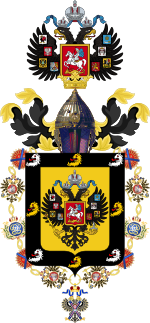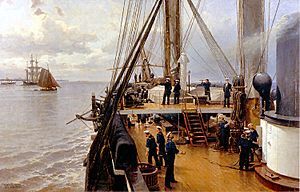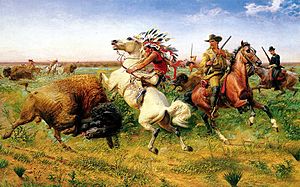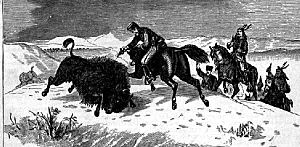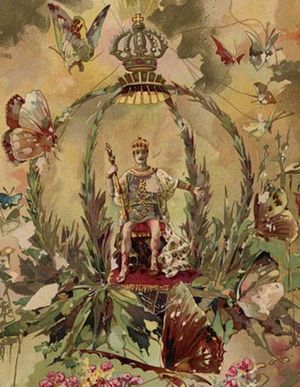Grand Duke Alexei Alexandrovich of Russia facts for kids
Quick facts for kids Grand Duke Alexei Alexandrovich |
|
|---|---|
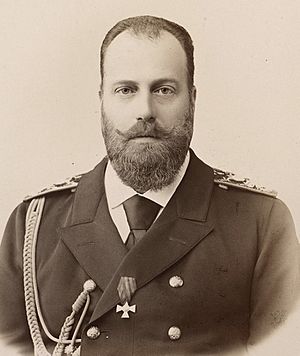
Alexei Alexandrovich, c. 1880-90s
|
|
| Born | 14 January 1850 Winter Palace, Saint Petersburg, Russian Empire |
| Died | 14 November 1908 (aged 58) Paris, France |
| Burial | Grand Ducal Mausoleum |
| Spouse | Alexandra Zhukovskaya |
| Issue | Alexei Alexeevich |
| House | Holstein-Gottorp-Romanov |
| Father | Alexander II of Russia |
| Mother | Marie of Hesse |
Grand Duke Alexei Alexandrovich of Russia (born January 14, 1850, in St. Petersburg – died November 14, 1908, in Paris) was the fifth child and fourth son of Alexander II of Russia, who was the Emperor of Russia. His mother was Maria Alexandrovna (Marie of Hesse).
Alexei was chosen to have a career in the navy from a young age. He started his military training when he was just seven years old. By the time he was 20, he had become a lieutenant in the Imperial Russian Navy. He had also visited many of Russia's naval ports in Europe. In 1871, he traveled to the United States and Japan as a special visitor, like a goodwill ambassador.
In 1883, he was given the important title of General-Admiral. He played a big part in getting new ships for the Russian navy and making naval ports more modern. However, after Russia lost badly in the Battle of Tsushima in 1905, he was removed from his command. He passed away in Paris three years later, in 1908.
Contents
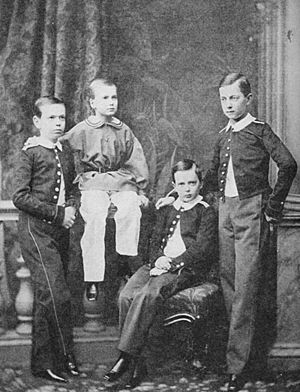
Grand Duke Alexei Alexandrovich Romanov was born in Saint Petersburg, Russia, on January 14, 1850. His father was Emperor Alexander II of Russia, and his mother was Empress Maria Alexandrovna (Marie of Hesse). He had several older and younger brothers and sisters, including Alexander III of Russia, who later became emperor.
From childhood, Alexei was prepared for a career in the navy. When he was seven, he became a midshipman, which is a junior officer rank. The next year, Konstantin Nikolayevich Posyet became his teacher. During winters, Alexei studied naval theories. In summers, he trained on Russian warships in the Baltic Sea, near Saint Petersburg.
He trained on various sailing ships, including the yacht Shtandart in 1860 and the frigate Svetlana in 1864. In 1866, he sailed on the frigate Oslyabya during a long training trip to the Azore Islands.
On September 18, 1866, Alexei was promoted to lieutenant. He continued his naval career as an officer on the frigate Alexander Nevsky. He sailed across the Mediterranean Sea to Greece, where he attended his cousin Olga Konstantinovna's wedding.
In 1868, he took a long journey through southern Russia. He traveled by train, then by ship down the Volga to the Caspian Sea. He visited places like Baku and Iran. He then crossed the Caucasus mountains and sailed to Constantinople (modern-day Istanbul), Athens, and the Azore Islands. On the way back, his ship, the Alexander Nevsky, was wrecked in a storm off the coast of Jutland. Luckily, most of the crew survived and reached shore safely.
In January 1870, Alexei turned 20, which was the age of adulthood in Russia. He took two important oaths: one for military service and one to show his loyalty to the Russian Imperial family. In June 1870, he began the final part of his training. This included navigating a small boat with a steam engine from Saint Petersburg to Arkhangelsk through a canal system. After visiting schools and factories in Arkhangelsk, he trained in arctic conditions aboard the corvette Varyag. This journey took him to the White Sea, Barents Sea, Novaya Zemlya, and even to ports in northern Norway and Iceland. He returned home in September.
Overseas Journeys
Visiting the United States
The Voyage to America
After an American naval group visited Saint Petersburg in 1867, Russia decided to send its own important naval visit to the United States. Grand Duke Alexei was chosen to lead this trip. The official announcement was made in June 1871.
The Russian fleet, led by Admiral Konstantin Nikolayevich Posyet, included several frigates and other ships. Alexei served as a lieutenant on the frigate Svetlana. The fleet mostly sailed across the Atlantic Ocean to save coal. The crew included 200 officers and over 3,000 sailors. They left Russia on August 20, 1871.
Their first stop was in Copenhagen, Denmark, where Alexei visited King Christian IX of Denmark. In the English Channel, British navy ships met them and escorted them to Plymouth, England. Alexei was supposed to visit Balmoral Castle, but the visit was canceled because the Prince of Wales (who later became King Edward VII) was very ill.
The Russian fleet left Plymouth on September 26 and stopped in Funchal, Madeira Islands, before heading to New York.
American ships met the Russian fleet as they approached New York. A special welcoming committee had been formed in New York, with important people like Theodore Roosevelt, Sr. as members. After a short delay due to weather, the Russian fleet arrived in New York Harbor on November 21, 1871. Grand Duke Alexei was greeted by General John Adams Dix. A military parade was held in the city, and Alexei also attended a church service at the Russian chapel.
East Coast Adventures
In New York, Alexei visited the Brooklyn Navy Yard, a military fort, and reviewed the Fire Department. A special trip by steamboat took him up the Hudson to visit the United States Military Academy at West Point.
Many fancy balls were held in his honor, including big ones at the Navy Yard and the Academy of Music. Alexei also went to see operas and enjoyed shopping at famous stores like Tiffany's, where he bought jewelry and statues.
On December 2, 1871, Alexei attended a ceremony at the National Academy of Design. There, a painting called Farragut in the shrouds of the Hartfort at the battle of Mobile Bay was given as a gift from the people of New York to his father, Tsar Alexander II. The painting was placed on the Russian flagship to be taken back to Russia.
On December 3, Alexei traveled to Philadelphia. He visited colleges, factories, and the Navy Yard. He was very interested in a fair where he received an Afghan Hound dog as a gift.
On December 6, 1871, Alexei visited the Smith & Wesson gun factory in Springfield, Massachusetts. He was given a special, decorated revolver. This gift was a smart move by the company, hoping to get more orders from Russia. The Grand Duke proudly showed off his new revolver during his travels in the American West and even carried it on a buffalo hunt with the famous "Buffalo Bill" Cody.
From December 7 to 14, he stayed in Boston. He was welcomed at City Hall and the State House. He visited Harvard University, local schools, and learned about the American education system. He also saw the Bunker Hill battlefield and shipyards. A large music festival was held for him, where 1,200 schoolchildren sang. A special song was composed for his visit. A grand ball was also held at the Boston Theatre.
A Quick Trip to Canada
On December 17, Alexei took a train to Canada. He stopped in Montreal and had breakfast with the mayor. He also passed through Ottawa and Toronto. On December 22, 1871, he reached Clifton Hill, Niagara Falls. From there, he took a sleigh to visit the famous Niagara Falls. He even put on special suits to go under the falls! He then crossed the Niagara River on a suspension bridge to see the American side of the falls.
Midwest Explorations
On December 23, 1871, Alexei left for Buffalo, New York, where he spent Christmas. On December 26, he arrived in Cleveland, visiting iron mills and factories. He also reviewed the Cleveland Fire Department. He then stopped in Detroit on his way to Chicago, arriving on December 30.
Chicago was still recovering from a huge fire. The mayor told Alexei that they had mostly "ruins and debris" to show. Alexei visited the destroyed areas and was impressed by how quickly the city was rebuilding. He gave US$5,000 (a lot of money back then) in gold to help the homeless people of Chicago. He also visited meatpacking plants.
From January 2 to 4, he visited Milwaukee, and on January 5, he arrived in St. Louis, Missouri, where he stayed for over a week. Finally, on January 12, he reached Omaha, Nebraska.
The Great Royal Buffalo Hunt
Big preparations were made for a special buffalo hunt. General Joel Palmer organized soldiers, cavalry, musicians, cooks, and more.
Grand Duke Alexei arrived at Fort McPherson, Nebraska on January 13, 1872, by a special train. He was with important American generals like Philip Sheridan and George Armstrong Custer. They were greeted by a large crowd and Buffalo Bill Cody, a famous frontiersman. Buffalo Bill's partner, Texas Jack Omohundro, led the group to the hunting grounds.
The camp was set up with many tents, including special ones for Alexei with carpets and stoves. Buffalo Bill had arranged for about 600 Native American warriors from different Sioux tribes, led by Chief Spotted Tail, to meet Alexei. They were given food and tobacco for their help.
Chief Spotted Tail, dressed in a suit, greeted the Grand Duke. For Alexei's entertainment, the Native Americans showed off their amazing horsemanship, spear-throwing, and bow-shooting skills. They also performed a mock fight and a grand war dance. A formal meeting took place, and a peace pipe was shared. Spotted Tail used this chance to ask for hunting rights and more trading stores for his people.
The main buffalo hunt happened on Alexei's 22nd birthday, January 14, 1872. The hunting party chased a buffalo herd. Alexei rode Buffalo Bill's famous buffalo horse, "Buckskin Joe," which was trained to run fast so the rider could get a good shot. The next morning, Alexei hunted with Two Lance, a Sioux chief, to see the Native American way of hunting.
After the hunt, General Sheridan suggested that Buffalo Bill show Alexei how to drive a stagecoach fast across the plains. The heavy carriage bounced wildly, but Alexei enjoyed the ride. When they said goodbye at Fort McPherson, Alexei gave Buffalo Bill a fur coat and expensive cufflinks.
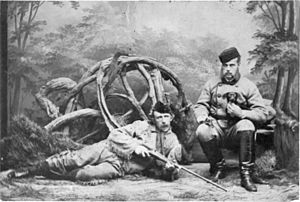
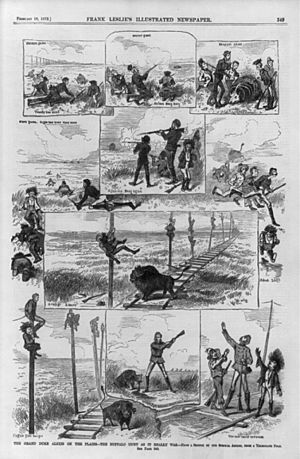
From Fort McPherson, the train continued to Denver, where Alexei arrived on January 17. He attended a ball and visited some mines. He enjoyed buffalo hunting so much that he hunted again near Colorado Springs, Colorado, on his way back through Kansas to St. Louis.
General Custer became a good friend of the Duke and traveled with him through Kansas, St. Louis, New Orleans, and Florida. They continued to write to each other until Custer's death. In the United States, this hunt is remembered as "The Great Royal Buffalo Hunt." Today, a town in Nebraska even holds an annual event to re-enact it.
Alexei received a Native American wigwam and a bow and arrows as gifts from Chief Spotted Tail. He took them back to St. Petersburg, where they are now kept in a museum in Tver. To remember his American adventures, Alexei would host special parties every year. Actors would arrive in old carriages, and "Indian" canoes would be on the palace lake. Men with swords and tomahawks would dance with women in old skirts, trying to recreate the feeling of the American Old West.
Southern States and Mardi Gras
While in St. Louis, Alexei made a short visit to Cincinnati on January 26. On January 28, he left by train for Louisville, Kentucky, where he visited the famous Mammoth Cave.
He continued his trip by steamboat, arriving in Memphis, Tennessee, on February 2, 1872. After visiting Memphis, he left on February 8 and, after a stop in Vicksburg, Mississippi, finally arrived in New Orleans.
In New Orleans, Alexei was the special guest at the 1872 Mardi Gras celebrations. He reviewed the very first Rex parade, which was a new daytime parade.
Many stories are told about the Grand Duke's visit to New Orleans. Some say local business leaders planned the first daytime parade just for him, but that's not quite true. New Orleans was trying to recover from the Civil War, and city leaders wanted to make Mardi Gras parades more organized. They used Alexei's visit as a great chance to launch their new parade. A new group of citizens formed, called the School of Design, and their leader was named Rex, the King of Carnival.
Alexei watched the Rex parade. It's said that the song "If Ever I Cease to Love" became the Rex parade's anthem because it was his favorite tune. This song was already popular in New Orleans before the parade. The lyrics were changed for the occasion to include a funny line about Alexei:
Ride a buffalo in Texas
If Ever I Cease to Love"
The parade Alexei saw was different from today's parades. Rex rode a horse, not a float, and many people in costumes just walked along. However, bands played the Russian national anthem in his honor. Many Mardi Gras traditions, like choosing Rex and the parade's colors, started with Alexei's visit.
The Russian fleet left Pensacola, Florida, on February 22, 1872. It's said they even brought hundreds of pounds of iced buffalo meat with them!
Far East Tour
On its way back to Russia, the fleet stopped in Havana, Cuba, on February 29, 1872. Then they sailed to Rio de Janeiro, Brazil, arriving on June 3, 1872. Alexei hosted Emperor Pedro II of Brazil and his court aboard the Svetlana.
Continuing to the Far East, the fleet also stopped in Cape Town, South Africa; Batavia (now Jakarta), Indonesia; Singapore; Hong Kong; Canton; and Shanghai.

The Russian fleet arrived in Japan on October 15, 1872, anchoring in Nagasaki harbor. Alexei was greeted by the governor. His visit included a special dinner, trips to the countryside, and a tournament of Japan's best wrestlers. On October 22, Alexei visited a small village called Inasa, where a Russian community lived. He saw hotels named "Kronstadt" and "Moscow" and the Russian cemetery.
The fleet left Nagasaki on October 24 and sailed to Kobe, where Alexei was again welcomed by the governor. He also attended a play at the local theater.
On November 1, the Russian fleet sailed to Yokohama. On November 5, Grand Duke Alexei was officially received by the Japanese Emperor Meiji. The next day, he watched a parade of the Japanese armed forces. A few days later, the Emperor visited the Russian fleet in Yokohama at Alexei's invitation. Because of Alexei's request, 34 Japanese Christians were pardoned and set free by the Emperor.
On November 26, the Russian fleet sailed for Vladivostok, reaching the Russian Pacific Fleet base on December 5. This was almost a year and a half after they had left Russia. Alexei then returned to St. Petersburg by traveling across Siberia.
Visit to England
In 1874, Alexei went with his father to England. They visited his sister, Grand Duchess Marie Alexandrovna, who had recently married Prince Alfred, Queen Victoria's son.
Alexei's Palace
After his long trip to America, Alexei wanted a suitable home. He bought an old building at 122 Moika River Embankment in Saint Petersburg. The building was completely redesigned and rebuilt by architect Maximilian Messmacher. It became a very interesting example of Saint Petersburg's varied architecture, with each side of the building having a different style. The iron and stone fence around the palace and its gardens is also special. The main gates still have the Grand Duke's special symbol.
In 1910, part of the gardens was sold to build a candy factory. Even though the palace was declared a national landmark in 1968, it was in poor condition for many years. After being restored in the early 2000s, it reopened in 2008 as the St. Petersburg Music House.
In 1873, Alexei Alexandrovich was put in charge of the Imperial Naval Guards. He also joined a committee that worked on shipbuilding and naval weapons for the Russian navy.
During the Russo-Turkish War (1877–1878), he was promoted to commander of the Russian Naval Forces on the Danube River. In January 1878, he received a high honor, the Order of St. George, for his excellent leadership of naval forces. This included building and maintaining bridges and crossings, and protecting them from enemy attacks.
In 1880, he was promoted to general adjutant. In 1882, after his brother Alexander became emperor, Alexei was appointed head of the Naval Department. In 1883, he also became the General-Admiral of the Russian Imperial Fleet.
Even though he didn't control every small detail of the military, Alexei was very involved in planning for the navy and army. His influence with the Tsar gave him a strong voice in important decisions.
Besides leading Russia's fleets, Alexei was also in charge of naval cadet schools and several army regiments.
As commander-in-chief of the navy, his main job was to modernize the fleet, keeping up with fast technological changes. During his time, the navy's budget increased five times. He launched many new battleships that replaced older ironclad ships. He was key in getting several types of battleships for the Russian navy, including:
- The Peresvet class, inspired by British battleships.
- The Borodino class, based on a French design.
- The Petropavlovsk class, designed in St. Petersburg.
- The Navarin class, similar to British battleships.
He also had older ironclad ships rebuilt by a French shipyard. He also put new cruisers into service, like the famous Aurora.
Alexei was very important in modernizing the Russian navy. He rebuilt and improved military harbors in Sevastopol, Liepāja, and Port Arthur. He also increased the number of navy yards and expanded dry-docks in Kronstadt, Vladivostok, and Sevastopol. He reorganized the navy, setting new standards for naval skills, creating rules for rewarding long-serving captains, and increasing the number of officers and crew.
When tensions grew in the Far East, he ordered more ships to be sent to Port Arthur, including the battleship Petropavlovsk.
However, some experts, like naval engineer Alexei Nikolaevich Krylov, pointed out problems with Alexei's work. There was no clear plan for the navy, and ships were not built based on their specific roles. There were too many different types of ships. Designs were often copied from foreign navies, meaning they were already 6–7 years old when launched. Their armor and equipment were often not good enough.
Alexei seemed to realize some of these issues. He decided to have more battleships of the same type and to have them designed abroad to meet Russia's needs. But even though he admired the British navy, the new battleships were designed in France and had flaws. The new Borodino-class battleships had unstable designs, which proved to be a major weakness for the Russian navy.
Disgrace and Retirement
Over the years, Grand Duke Alexei's reputation suffered. People saw him as someone who spent too much money and was not very serious, especially on "ladies of no reputation." He bought a grand house in Paris and even built a new part of his St. Petersburg palace for his mistress, a ballerina named Elizabeth Balletta. Some people, like Kaiser Wilhelm II, claimed that no ship could be bought for the Russian Fleet without Alexei taking a large sum of money for himself. In 1903, a huge amount of money – half of the Russian navy's budget – disappeared without any new ships being built. Alexei was suspected of being involved in this misuse of funds.
When the Russo-Japanese War started in 1904, the Russian fleet in the Pacific fought bravely but was eventually destroyed. The Baltic Fleet, sent as backup, was completely defeated in the Battle of Tsushima. Alexei had opposed changes to the navy and was seen as partly responsible for these terrible losses. In 1904, angry crowds smashed the windows of his St. Petersburg palace. In 1905, when his mistress Balletta appeared on stage wearing many diamonds, the audience shouted: "She has our fleet in her ears! On her every finger there is a cruiser!"
On June 2, 1905, Alexei was removed from his command and retired from the navy.
Life at Court and Later Years
Away from his naval duties, Alexei enjoyed the finer things in life. He hosted many parties and collected beautiful silver and other artworks for his palace. Sometimes, he even designed his own clothes.
Besides his military work, Alexei was also the head of the Imperial Commission for the Promotion of Ballet, showing his interest in the arts.
In 1904, he became one of the godparents for Tsarevich Alexei, who was the son of Tsar Nicholas II. Many other important people were also godparents, including kings and queens from other countries. All soldiers serving in the military during the Russo-Japanese War were also declared godfathers to the young Tsarevich Alexei.
Death
After his brother Grand Duke Sergei Alexandrovich of Russia was assassinated in February 1905, and after he was removed from the navy in June of that same year, Alexei Alexandrovich spent most of his time in his house in Paris, which he had bought in 1897. At his home, he welcomed writers, painters, actors, and especially actresses. He had always been more interested in art and fashion than in military service. He was known for his knowledge of Paris's social, artistic, and literary life. His large figure was often seen at restaurants and theaters, especially on opening nights of new plays.
Years of comfortable living eventually affected his health. He died of pneumonia in Paris on November 27, 1908. His nephew, Tsar Nicholas II, was reportedly very sad about his death, saying Alexei was his favorite uncle. In 2006, Alexei's diary, written in English, was found in the Russian National Library. It covers the years from 1862 to 1907 and has not been published yet.
In Popular Culture
- The Adventure of the Seven Clocks (1952), a Sherlock Holmes story, involves attempts by a group called the Nihilist movement to assassinate the Grand Duke.
- The 1973 Lucky Luke comic book Le Grand Duc features a Russian Grand Duke who visits the Wild West.
- In 1977, actor Christopher Lee played a Russian Grand Duke hunting buffalo in three episodes of the TV series How the West Was Won.
- The western hunt is mentioned in the 1994 film Maverick, starring Mel Gibson. In the film, the Duke is tricked into thinking he is hunting a Native American after getting bored with hunting animals.
- He appears as a character in Boris Akunin's novel The Coronation (2000) under the name Georgi Aleksandrovich.
Honors
 Austria-Hungary: Grand Cross of St. Stephen, 1874
Austria-Hungary: Grand Cross of St. Stephen, 1874 Denmark:
Denmark:
- Knight of the Elephant, June 17, 1866
- Cross of Honour of the Order of the Dannebrog, December 21, 1878
 France: Grand Cross of the Legion of Honour, November 1874
France: Grand Cross of the Legion of Honour, November 1874 Grand Duchy of Hesse: Grand Cross of the Ludwig Order, June 8, 1857
Grand Duchy of Hesse: Grand Cross of the Ludwig Order, June 8, 1857 Kingdom of Italy: Knight of the Annunciation, November 19, 1868
Kingdom of Italy: Knight of the Annunciation, November 19, 1868 Empire of Japan: Grand Cordon of the Order of the Chrysanthemum, June 17, 1882
Empire of Japan: Grand Cordon of the Order of the Chrysanthemum, June 17, 1882 Oldenburg: Grand Cross of the Order of Duke Peter Friedrich Ludwig, with Golden Crown, March 11, 1863
Oldenburg: Grand Cross of the Order of Duke Peter Friedrich Ludwig, with Golden Crown, March 11, 1863 Kingdom of Portugal: Grand Cross of the Tower and Sword, July 26, 1866
Kingdom of Portugal: Grand Cross of the Tower and Sword, July 26, 1866 Kingdom of Prussia:
Kingdom of Prussia:
- Knight of the Black Eagle, January 14, 1860
- Pour le Mérite (military), March 22, 1879
- Grand Commander's Cross of the Royal House Order of Hohenzollern, June 11, 1879
 Saxe-Weimar-Eisenach: Grand Cross of the White Falcon, June 1, 1868
Saxe-Weimar-Eisenach: Grand Cross of the White Falcon, June 1, 1868 Siam: Knight of the Order of the Royal House of Chakri, July 4, 1897
Siam: Knight of the Order of the Royal House of Chakri, July 4, 1897
 Sweden-Norway: Knight of the Seraphim, August 28, 1873
Sweden-Norway: Knight of the Seraphim, August 28, 1873 Württemberg: Grand Cross of the Württemberg Crown, 1864
Württemberg: Grand Cross of the Württemberg Crown, 1864
Images for kids
See also
 In Spanish: Alejo Alexandrovich de Rusia para niños
In Spanish: Alejo Alexandrovich de Rusia para niños


